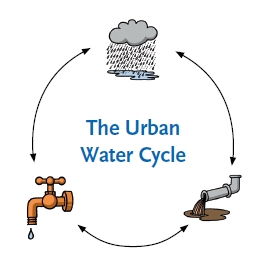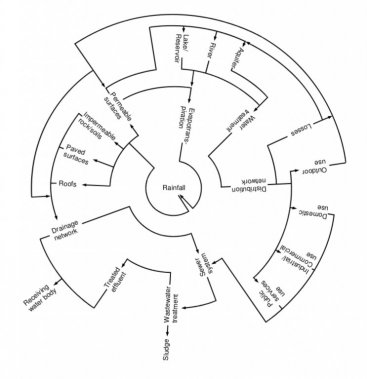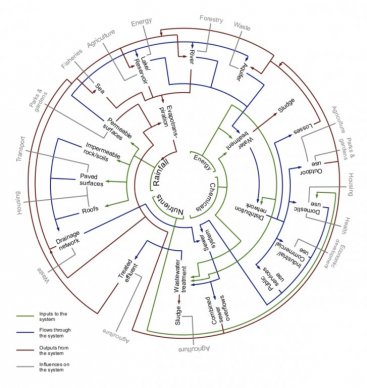Executive Summary
Introduction
Throughout the world, the management of water in cities is confronted with rising challenges. Water demand is increasingly outstripping supplies as urban populations expand and economies grow; flooding is becoming more frequent as urbanisation spreads and natural hydrological regimes are altered; the health (see also Water, Sanitation and Health) of citizens, particularly in low-income neighbourhoods, is jeopardised as a lack of adequate sanitation services which causes outbreaks of waterborne diseases. Deteriorating infrastructure, increasing fuel costs and the impacts of climate change further amplify the pressures on urban water systems.

The three basic components of the urban water cycle. Source: PHILIP et al.(2011)
Composed of different elements, urban water resources and their use are all part of a single system – the urban water cycle – which in itself is inextricably linked to the larger watershed (see also Integrated Water Resources Management). Yet in spite of this, the management of this system is often fragmented, with the design, construction and operation of water supply (see also Water Sources, Water Purification, Water Distribution), sanitation systems and drainage interventions (see also Stormwater Management) carried out in isolation from one another. Many decisions in conventional urban water management are taken with little or no consideration of their negative impacts in other areas or for the entire system, causing inefficiencies and misinvestments that could be avoided.
Greater integration is an obvious way of overcoming these issues. Local governments, together with other stakeholders in charge of urban water management, can make a difference by adopting such an approach, both from an infrastructure as well as a governance perspective.
Integration and Sustainability
The concept of Integrated Urban Water Management (IUWM) is founded on the premise that the design and management of the urban water system is based on an analysis and optimisation of the entire system (VAN DER STEEN & HOWE 2009). Rather than disconnecting the various tasks related to urban water resources, an integrated approach to design and management leads to opportunities for a more efficient and sustainable use of resources. Examples of such opportunities include:
- The exploitation of stormwater (see also Urban Rainwater Harvesting) and treated wastewater effluent (see also Wastewater Reuse at Home) as alternative water supply sources.
- The control of stormwater quality and quantity to achieve more efficient wastewater treatment in combined sewer systems.
- The development of aquatic ecosystems (see also the lecture on Natural Systems) such as wetlands (see also Freesurface Constructed Wetland) for water purification and natural flood protection purposes.
Integrated planning ensures that solutions, which maximise multiple benefits in different components of the urban water cycle, while minimising negative impacts in others, are more easily identified and exploited. Such holistic management thereby increases the likelihood that decisions taken and investments made achieve a more sustainable use of the water resources as a whole.
Linkages between Elements of the Urban Water Cycle and other Aspects of Urban Planning
As indicated above, the linkages within the urban water cycle are numerous. These linkages are most clearly seen between the three basic components of the urban water cycle(see Implementation Tools Introduction), namely water supply, wastewater management (see Sanitation Systems) and stormwater management as shown in the diagram below.

The urban water cycle. Source: PHILIP et al.(2011)
These linkages refer not only to the physical interrelationships between the uses and flows of water within a city but also to the institutions in charge of governing the water cycle (see also The Role of Local Governments in Urban SSWM), which are confronted with an entirely different set of challenges to improve integration.
IUWM is, however, about more than just the urban water cycle and its governance. Water in a city is also directly and indirectly linked with a range of other urban management sectors, including the following:
- Solid waste management:Badly managed waste can pollute water resources and block drainage channels causing incidences of local flooding and generating pools of stagnant water.
- Energy:Water services require a reliable supply of energy for pumping and treatment operations. In addition, water can be used to generate energy through hydropower schemes and the production of biogas (see Anaerobic Digestion).
- Transport:Vehicles are a source of water pollution, e.g. through the dispersal of oils and heavy metals in stormwater runoff. Flooding events may also disrupt traffic and damage transport infrastructure.
- Housing:Urban expansion involving the construction of housing leads to a growing demand for additional water supplies and wastewater infrastructure (see also Sanitation Systems) to serve the new communities.
- Land-use planning:The urbanisation of undeveloped land alters the local hydrology by increasing the area of impermeable surfaces (see also Stormwater Management), which generates additional stormwater runoff.
- Economic development:Economic growth requires more water abstraction and increases the risk of pollution from industrial wastewater (see also Water Pollution) discharges.
- Health:Inadequate sanitation (see also Water Sanitation and Development) and contaminated water supply sources (see also Pathogens and Contaminants) cause the spread of waterborne diseases. Poor drainage also provides breeding grounds for mosquitoes thereby increasing the risk of parasitic diseases.
- Urban agriculture:Urban agricultural production requires a reliable supply of water for irrigation. Recycling the nutrients contained in wastewater (see The Nutrient Cycle) is also a valuable source of cheap fertiliser.

Some of the linkages within and beyond the urban water cycle. Source: ICLEI (2011)
An IUWM approach therefore requires close coordination and cooperation between decision-makers from various urban management departments as well as other relevant stakeholders in these different sectors. Multi-sectoral coordination at the planning stage can help to identify synergies and conflicts between different elements of urban planning which can then be systematically addressed to make the most of available resources.
Principles of Sustainable Urban Water Management
The ultimate goal of a more integrated approach to urban water management is to make local development more sustainable. Sustainable development has been defined by the World Commission on the Environment and Development as: “Development that meets the needs of the present without compromising the ability of future generations to meet their own needs” (PHILIP et al. 2011).
In the case of water management, sustainability can be divided into three major dimensions:
- Social – Water management contributes to the quality of life of all citizens
- Economic - Operation and maintenance of water services are cost-efficient
- Environmental - The ecological balance of natural water systems is maintained by not abstracting more than can be replenished and preventing pollution and erosion
- In addition, sustainable water management should meet social, economic and environmental needs over:
- Time, i.e. management decisions and actions are taken with consideration for long-term impacts; and
- Space, i.e. management decisions and actions are taken with consideration for upstream and downstream impacts.
When applied to the three basic components of urban water management, the different dimensions of sustainability can be considered as follows (PHILIP et al. 2011):
- Water supply (see also Implementation Tools Introduction):To provide a safe and reliable supply of water in the long-term to all citizens in sufficient quantities, at the lowest possible cost and using the least possible non-renewable energy, without abstracting water from the environment that cannot be naturally replenished under varying climatic conditions.
- Sanitation Systems:To provide all citizens with adequate sanitation in the long-term, at the lowest possible cost and using the least possible non-renewable energy, whilst minimising the risk to human health and maintaining the net waste output from the city to below the carrying capacity of the receiving environment.
Stormwater Management:To reduce the risk of flooding for all stakeholders to acceptable levels, even under future climate change scenarios, whilst maintaining a balanced natural water cycle and healthy aquatic environment.
Strategic Planning - Preparing for the Future.SWITCH Training Kit Module 1. Integrated Urban Water Management in the City of the Future
Managing Water in the City of the Future. Strategic Planning and Science
Integrated Urban Water Management. Lessons and Recommendations from Regional Experiences in Latin America, Central Asia, and Africa
Review of a set of Integrated Urban Water Management (IUWM) initiatives and pilot studies funded by the World Bank’s Water Partnership Program (WPP) in Latin America and the Caribbean, Europe, Central Asia and sub-Saharan Africa.
CLOSAS, A. SCHURING, M. RODRIGUEZ, D. (2012): Integrated Urban Water Management. Lessons and Recommendations from Regional Experiences in Latin America, Central Asia, and Africa. (= WPP Case Profile No. 1 ). Washington DC: World Bank URL [Accessed: 06.02.2013]Sustainable Water Management in the City of the Future. Findings from the SWITCH Project 2006-2011
Consolidating the findings from the ‘SWITCH – Managing Water in the City of the Future’ project (2006-2011), this book describes the research and knowledge sharing activities and outcomes from the 11 participating cities throughout the world that worked to facilitate a paradigm shift in urban water management through a more integrated approach.
HOWE, C. A. ; VAIRAVAMOORTHY, K. ; STEEN, P. N. van der (2011): Sustainable Water Management in the City of the Future. Findings from the SWITCH Project 2006-2011. Delft: UNESCO-IHE URL [Accessed: 06.02.2013]The Future of Water in African Cities. Why Waste Water?
This extensive study on water in African cities argues that the traditional approach of one source, one system, and one discharge cannot close the water gap. A more integrated, sustainable, and flexible approach, which takes into account new concepts such as water fit to a purpose, is needed. The book explores the opportunities for cities in Africa to implement Integrated Urban Water Management (IUWM) approaches both in terms of technical and institutional solutions and provides examples where this is being achieved.
JACOBSEN, M. ; WEBSTER, M. ; VAIRAVAMOORTHY, K. (2012): The Future of Water in African Cities. Why Waste Water?. Washington DC: World Bank URL [Accessed: 06.02.2013]The Future of Water in African Cities. Why Waste Water? Integrated Urban Water Management for Africa: Background Report
A background report providing an overview of the concept of Integrated Urban Water Management (IUWM) and its potential to overcome current and future water resources challenges in Sub-Saharan Africa. The report outlines the required framework for a more integrated approach to urban water management as well as providing a number of case studies highlighting good practice examples from the region.
JACOBSEN, M. ; WEBSTER, M. ; VAIRAVAMOORTHY, K. (2011): The Future of Water in African Cities. Why Waste Water? Integrated Urban Water Management for Africa: Background Report. Washington DC: World Bank URL [Accessed: 06.02.2013]Towards the Adoption of Integrated Urban Water Management for Planning
Research paper, which describes the processes that enable the application of an Integrated Urban Water Management (IUWM) approach to planning. The paper discusses principles, drivers and benefits of IUWM and provides an overview of a framework developed to adopt this approach to strategic planning of urban water systems.
MAHEEPALA, S. (2010): Towards the Adoption of Integrated Urban Water Management for Planning. (= Proceedings of International Congress on Environmental Modelling and Software, 5th to 8th July 2010 ). Ottawa, Ontario, Canada: International Environmental Modelling and Software Society (iEMSs) URL [Accessed: 06.02.2013]Integrated Urban Water Management. A Review of Current Australian Practice
Review of Australian urban development and practice in the application of the concept of integrated urban water management (IUWM). The purpose of this review is to comment on the success or otherwise, to date, of integrated urban water management in Australia, derive principles for the application of integrated urban water management, identify knowledge gaps and provide signposts to fruitful areas of future research and demonstration.
MITCHELL, V. G. (2004): Integrated Urban Water Management. A Review of Current Australian Practice. Australia: CSIRO &Australian Water Association (AWA) URL [Accessed: 06.02.2013]India, Urban Sanitation, and the Toilet Challenge
This research brief builds upon a literature review and stakeholder interviews in India on urban sanitation to examine the public policy landscape for sanitation innovation in the country.
ELLEDGE, M.F. MCCLATCHEY, M. (2013): India, Urban Sanitation, and the Toilet Challenge. Durham: Research Triangle Institute (RTI) International URL [Accessed: 25.11.2013]The “city as a catchment” approach.SWITCH Training Kit:Melbourne, Australia
Case study describing Melbourne’s adoption of a “water sensitive city” approach and the implementation of Water Sensitive Urban Design techniques. This includes using an integrated approach to reduce its water consumption, exploit non-conventional sources of water supply and use alternative techniques to manage its stormwater runoff.
MITROTTA, E. (2011): The “city as a catchment” approach.SWITCH Training Kit:Melbourne, Australia. Freiburg: ICLEI European Secretariat GmbH URL [Accessed: 06.02.2013]A vision of Integrated Urban Planning comes to life in Stockholm’s Hammarby Sjöstad district. SWITCH Training Kit: Stockholm, Sweden
Hammarby Sjöstad’s holistic environmental vision incorporates aspects relating to waste, energy and water as part of one sustainable system. This vision is encompassed within the “Hammarby Model,” an eco-cycle, which promotes the integration of various technical supply systems, so that the waste from one system becomes a resource for another.
LOFTUS, A. C. (2011): A vision of Integrated Urban Planning comes to life in Stockholm’s Hammarby Sjöstad district. SWITCH Training Kit: Stockholm, Sweden. Freiburg: ICLEI European Secretariat GmbH URL [Accessed: 06.02.2013]http://www.unitar.org
This page contains an e-learning course on governance in urban sanitation.
